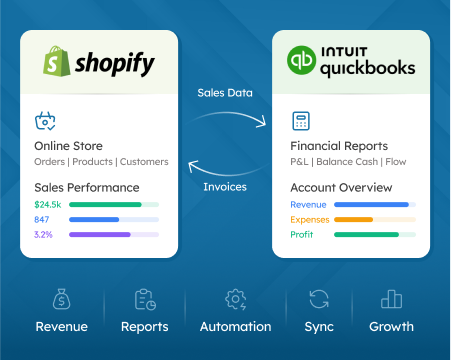The essential guide to understanding integrating Shopify and QuickBooks

Introduction
SyncTools’ integration of Shopify and QuickBooks is a deliberate step towards operational excellence, rather than just a technical configuration.
There are several advantages to this QuickBooks integration with Shopify, such as:
Automated bookkeeping
Automatically transfer data from Shopify to QuickBooks, reducing manual data entry and the potential for human error.
Sales, taxes, and customer information flow seamlessly into your accounting software.
Automated financial reporting
With automated financial reporting, errors, and human data entry are a thing of the past.
Using SyncTools, sales, taxes, and costs are sent straight from Shopify into QuickBooks, guaranteeing precise financial records.
Enhanced inventory management
Keep your inventory up-to-date across both platforms, reducing the risk of overselling and underselling.
Streamlined operations
With customer and order details automatically synced by SyncTools, businesses can focus on growth rather than getting bogged down in administrative tasks.
Key features of the integration include real-time data sync, comprehensive tax handling, and multi-store support, making it a versatile tool for businesses of all sizes.
Setting up for success: technical setup and configuration
- Initial setup
Use the QuickBooks app, powered by SyncTools, that is accessible in the Shopify App Store to link Shopify and QuickBooks. The procedure is simple and directed. - Configuration
Use SyncTools to personalize your data sync settings, including the frequency of data transfer and the details that are included. - Tax settings
Ensure that your tax settings in both Shopify and QuickBooks match to avoid discrepancies, a process simplified by SyncTools.
Financial clarity: automating sales and tax reporting
The potential of this connection to automate intricate financial activities is its core functionality.
Reporting on sales and taxes becomes simple when all transactions are precisely entered into QuickBooks.
Changes made in Shopify are automatically reflected in QuickBooks, providing a single source of truth for your stock levels.
This automation also applies to inventory management.
Beyond basics: advanced integration features
SyncTools provides expanded capability for companies wishing to take use of even more potential from their Shopify QuickBooks integration:
Custom Development: Utilize in-house solutions created by Shopify and QuickBooks specialists to customize the integration to your company’s particular requirements
.
Conclusion
A Step Towards Future-Proofing Your Business
More than just a technological improvement.
Integrating Shopify and QuickBooks with SyncTools is a calculated investment in the future of your company.
Businesses may set themselves up for long-term growth and success in the cutthroat eCommerce market by:
- Automating crucial processes
- Enhancing financial accuracy
- Discovering new efficiencies
As the digital economy evolves, the synergy between eCommerce platforms and accounting software, facilitated by tools like SyncTools, will become increasingly crucial.
Starting on the path of integration today means setting up your business for the challenges and opportunities of tomorrow.
